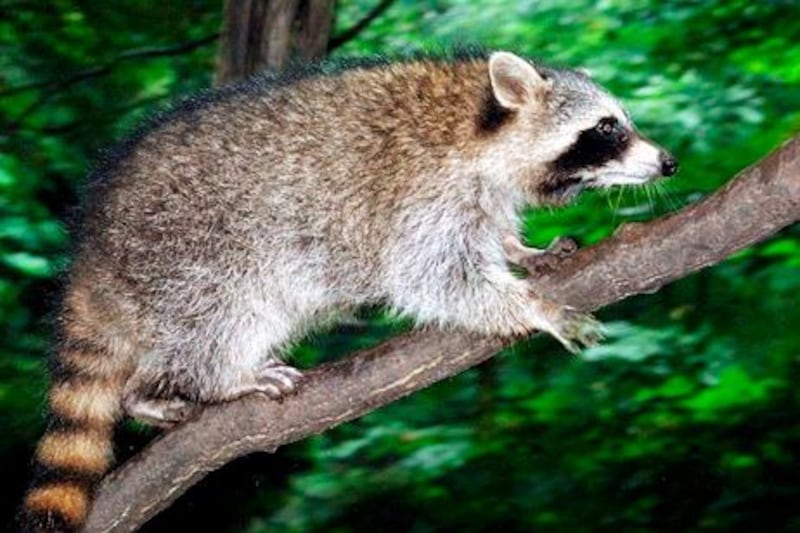BERLIN // They look like little bandits with mask-like black patches around their eyes, and they are marauding their way across Europe, ransacking rubbish bins, barging their way into people's homes, kicking owls out of their nests and devouring endangered species such as the pond turtle.
Raccoons, indigenous to North America, were first brought to Germany in the 1920s and bred in captivity for their fur. Everything went well for a few years but then, in the 1930s, a few of them escaped from a farm near Berlin.
Rumour has it that around the same time, Hermann Goering, the founder of the Gestapo and head of Adolf Hitler's air force as well as being Nazi Germany's most senior forestry official, ordered two pairs to be released into the wild near the Edersee Dam in western Germany so that they could be hunted.
However, no evidence has been found to back up that particular claim, but a number of British newspapers have taken to referring to the animals as "Nazi raccoons" as a result. There is no question that they are invasive.
Germany's current population of 500,000 raccoons derive from that handful of escaped and released raccoons.
Experts say their numbers have been exploding in recent years and will soon reach about one million.
The animals are conquering territory in Scandinavia and some have even managed to cross the Alps into southern Europe.
"They are spreading rapidly. The population was stagnant for a long time but something has happened in the last 10 years to cause them to thrive," Torsten Reinwald, a biologist at the German Hunting Federation, said
"They've adapted to their environment. They eat anything and they aren't especially particular about where they live."
Among Native Americans, the sharp-toothed beasts with pointy snouts and bushy striped tails were known for their foxlike cunning.
They are living up to that reputation in Germany, where they are making themselves comfortable in garages, garden sheds and attics. And once ensconced, they are hard to get rid of.
"You're in trouble if you get them in your attic," said Mr Reinwald.
"They defecate and urinate everywhere, eat through your insulation, bite through power cables and make a huge noise, especially at night. The cubs are born blind and spend a long time with their mothers during which they get bored and romp around. It's chaotic," he added.
Female raccoons tend to have five cubs a year. Hunting figures show how fast the population is expanding. In the 2000/2001 hunting season, just under 8,500 were shot and killed. In 2010/2011 it was 67,700.
Encounters with humans are becoming so frequent that raccoons regularly feature in police reports, and make for entertaining reading. In the town of Moritzburg, for example, holidaymakers called the police one night last week saying that their bungalow was being burgled.
Upon investigation, police officers found a raccoon climbing up the shutters. One raccoon even broke into the headquarters of the Dresden police force last year and was caught taking a nap outside an office. It was netted by the fire brigade and taken to an animal shelter.
Experts disagree on how damaging raccoons are to the environment.
There is evidence they are reducing numbers of the rare pond turtle from the lake region around Berlin, and in Thuringia, they have been scaring off the large Eurasian eagle-owl by climbing trees and making themselves at home in their nests.
"They're cheeky and forward," said Mr Reinwald.
The 1979 Bern Convention, an agreement on measures to preserve European wildlife, placed the raccoon on its list of most dangerous species and recommends strictly controlling its numbers.
However, raccoons are hard to shoot because they are nocturnal and cautious.
Hunters often use special traps to catch them, frequently with chocolate as bait.
Animal welfare groups say that even massive raccoon culls wouldn't stop them spreading.
"Killings will merely improve the living conditions for the remaining animals and they will multiply even faster," said Jorg Styrie of the Federal Animal Protection Association.
Experts say the priority is to reduce their numbers in nature conservation areas where they do the most damage to vulnerable wildlife.
In residential areas, there are some simple ways to keep the raiders at bay. For a start, resist the temptation to feed them, even if they flutter their eyes and look cute.
"That's the worst thing you can do. They'll just come back to beg for more even though they've got no trouble finding food on their own," said Mr Reinwald.
But now matter what us done, it looks as if Europeans will have to learn to live with the little pests.
"The species is firmly established here," said Ulf Hohmann, a forest biologist.






